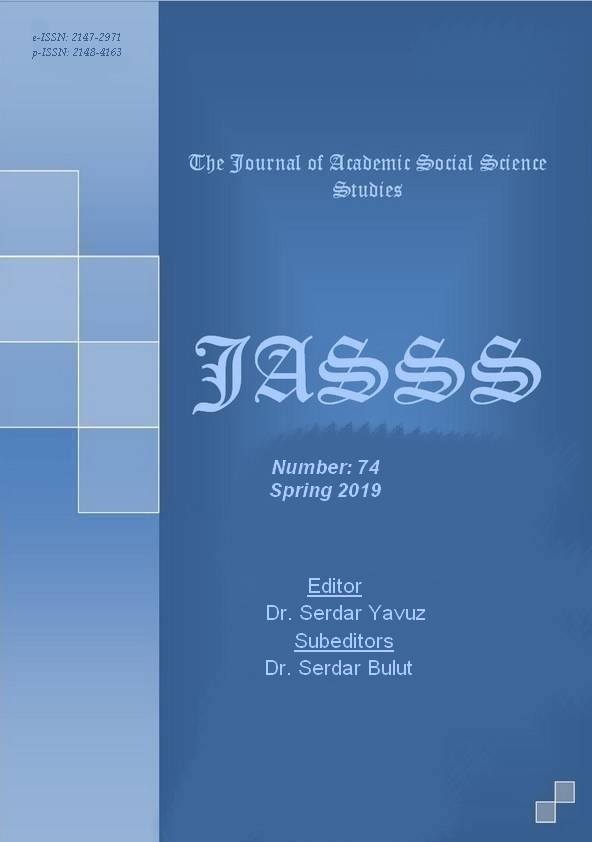ORTAOKUL ÖĞRENCİLERİNİN FEN BİLİMLERİ DERSİNDEKİ BİYOLOJİ KONULARINA YÖNELİK GÖRÜŞLERİNİN BELİRLENMESİ
Author :
Abstract
Öğrencilerin, araştırmayı seven, sorgulayabilen, neden-sonuç ilişkilerini fark edip, bunlar arasında mantıksal bağlantılar kurabilen, temel problemleri anlayıp çözebilen bireyler olarak yetiştirilmeleri gereklidir. Bu hedef doğrultusunda üzerinde durulması gereken önemli hususlardan biri Biyoloji Eğitimidir. Yapılan bu çalışmada ortaokul öğrencilerinin fen bilimleri dersindeki biyoloji konularına yönelik görüşlerinin belirlenmesi amaçlanmıştır. Araştırma yöntemlerinden genel tarama modeli kullanılmıştır. Araştırmanın çalışma grubunu İstanbul’da bir devlet okulunda öğrenim görmekte olan öğrenciler oluşturmaktadır. Çalışma grubunun örneklemini ilköğretim 5.,6.,7.ve 8.sınıflarından onar öğrenci seçilerek toplamda 40 öğrenci oluşturulmuştur. Öğrencilerin fen dersi müfredatı içerisinde yer alan biyoloji konularına yönelik görüşleri belirlenirken 6 adet açık uçlu sorulardan oluşan ölçme aracı kullanılmıştır. Veri toplama aşamasında öğrencilere herhangi bir müdahalede bulunulmadan tek aşamada gerçekleştirilmiş yarı yapılandırılmış açık uçlu sorular yardımıyla öğrencilerin yazılı cevapları alınmıştır. Toplamda 40 öğrenciden her biri Ö1, Ö2, Ö3, Ö4, … Ö40 şeklinde araştırmacı tarafından kodlanmıştır. Veriler analiz edilirken içerik analizi yapılmıştır. İçerik analizi ile veri toplama süreci sonunda elde edilen çok sayıdaki bilginin başlıca anlamlı bölümleri belirlenir, her bölümün kavramsal olarak ne anlam ifade ettiği bulunur, oluşturulan bölümler için kodlamalar yapılır ve kodlar belirli kategoriler altında toplanarak temalar oluşturulur (Yıldırım ve Şimşek, 2011). Her soru ve yanıtları için tablolar oluşturulmuştur. Verilen cevaplar kod adı altında yazılarak farklı temalar altına yerleştirilmiştir. Her kod içinde ayrı frekans değerleri oluşturulmuştur ve ardından temalar halinde değerlendirilmiş frekans yüzde dağılımları hesaplanmıştır. Araştırmanın güvenirliliği sağlamak için veriler bir alan uzmanı tarafından da incelenmiş ve oluşturulan tema ile kodlarla uzlaşı olup olmadığına bakılmıştır. Oluşturulan temalar için güvenirlik hesaplaması Miles ve Huberman’ın (1994) güvenirlik formülü kullanılarak hesaplanmıştır (Güvenirlik=Görüş birliği/Görüş birliği+Görüş ayrılığı).Araştırma sonrasında öğrencilerin fen dersi müfredatı içerisinde yer alan biyoloji konularına yönelik görüş ve önerileri belirlenmiş, incelenmiş ve verilere uygun önerilerde bulunulmuştur.
Keywords
Abstract
Students are required to be educated as individuals who can love and question the research, realize cause-effect relationships, establish logical connections among them, understand and solve the basic problems. One of the important points to be considered in this direction is Biology Education. In this study, it was aimed to determine the views of secondary school students on the biology subjects in the science course. General screening model was used in research methods. The study group consists of students studying at a public school in Istanbul. The sample of the study group was selected from the 5th, 6th, 7th and 8th grade primary school students and a total of 40 students were formed. While the students' opinions about the biology subjects included in the science curriculum, 6 open-ended questions were used. At the data collection stage, written answers of the students were taken by semi-structured open-ended questions which were carried out in a single stage without any intervention. A total of 40 students were coded in the form of Ö1, Ö2, Ö3, Ö4, ........ Ö40. Content analysis, the data collection process is obtained at the end of a large number of meaningful parts of the information is determined, each section conceptually what is meaning, the code is made for the sections created and the codes are collected under certain categories and themes are created (Yıldırım & Şimşek, 2011). Tables are created for each question and answer. The answers are written under the code name and placed under different themes. Separate frequency values were generated within each code, and then the frequency percentage distributions evaluated in themes were calculated. In order to ensure the reliability of the research, the data were also examined by a field expert and the theme was examined whether there was consensus with codes. The reliability calculation for the themes was calculated by using the reliability formula of Miles and Huberman (1994)(reliability=consensus/consensus+disagreement). After the research, opinions and suggestions of the students about the biology subjects included in the science curriculum were determined, examined and recommendations were made according to the data.
